“Roads? Where we’re going we don’t need roads.”
I think of this quote from “Back to the Future” as we fly from Port Moresby to Tufi Dive Resort. Doc Brown could well have been speaking of Papua New Guinea when he uttered this line. There are no towns below us — just lush jungle crawling down the sides of steep mountains, running unbroken to the sea. There are only two main roads (that don’t connect) but 21 paved airstrips in a country spanning just over 178,000 square miles (461,000 square km). To put that in perspective, PNG is around 15,000 square miles smaller than California and has a population of only 8.2 million, compared to almost 40 million in California. Arriving in a place so remote, I’m anticipating spectacular scuba diving in Papua New Guinea — and I won’t be disappointed.
Arrival at Tufi
We step off the small plane onto the gravel runway, and it seems the whole tiny village of Tufi is there to greet us. Also there to greet us are resort managers Brian and Roya Boustridge. Brian will drive our bags to the resort as we walk about 10 minutes along the edge of the village to the resort. We’re on the north coast of Oro Province, about 155 miles (250 km) directly east of Port Moresby as the crow flies. Tufi is perched atop one of the area’s many fjords, spits of land that jut like bony fingers into the Solomon Sea below. There’s no check-in process per se: the resort is so remote that they know you’re coming, so if you’ve booked online, which you likely have, your room will be ready with your name on the door and the key on the nightstand.
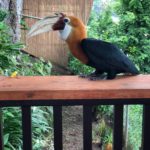
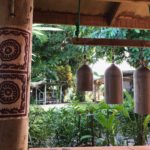
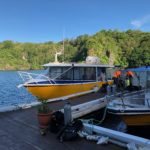
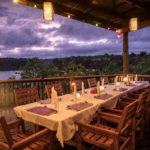
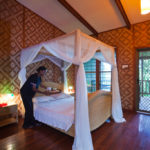
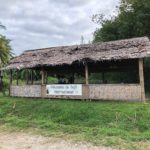
Views from the grounds and restaurant are spectacular, with 26 rooms and thatched-roof cabins scattered among the foliage and greenery. As we sit down to an early dinner, one of the resident Blyth’s hornbills swoops down and grazes the head of one of our party. Roya warns us that he’s a bit of a terrorist, and we should tie our swimsuits down if we dry them on our decks because he has a thing for bikinis.
Duly warned, we check out our rooms; my bungalow sits on a quiet path near the end of the property. There’s hammock swinging in the breeze on my oceanfront deck, but first it’s time to walk down the hill to visit the dive center. Tufi has four main dive boats and visits dozens of sites regularly. Although there are some within the surrounding fjords, the best sites are offshore. They vary from 20 and 50 minutes away via boat if the weather is good. Unfortunately, there are strong onshore winds during our visit. Consequently, getting out to the far reefs will be challenging, if not impossible. Nonetheless, we can’t wait to splash in the next morning.
Diving at Tufi
When I ask Brian how many dive sites there are at Tufi, off-the-cuff he says “thousands.” We’ll be diving our first day in Tufi fjord because of weather conditions, and our ride to the first site is only about 10 minutes into the narrower part of the fjord. The surrounding scenery is breathtaking. Fjord walls curve steeply upwards, covered in lush greenery. The water sparkles and the sun is warm without being oppressive. We spend our first two days exploring this fjord and the one next door, where there’s plenty of macro and small stuff to see. But the real highlight comes on our third day when a break in the wind means we head to the outer reefs.
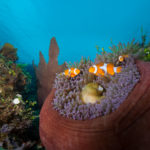
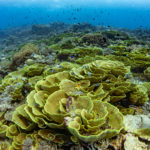
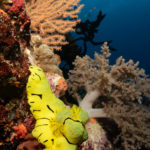
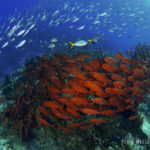

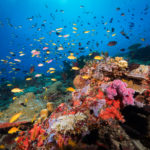
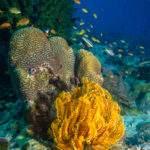
Our first stop is Stewart’s Reef, the closest to the resort. It takes about 30 minutes to get there and we drop in on the site in a big swell. Once we descend though, the sublime coral garden beneath us makes up for the rollicking boat ride. Shaped a bit like a comma, we fin along at around 60 feet (18 m), heading to its narrowest point with the wall to our left. There’s life everywhere — swirling reef fish, busy parrotfish, jacks — and the visibility is fantastic too. We reach the point, where the current is strongest, so we hold on or hook in to watch as sharks dart past. After 10 minutes or so, we unhook and drift to our left, slowly ascending into a dazzling hard-coral garden that spreads across the top of the reef as far as the eye can see.
Our second dive of the day at Honeymoon Reef is equally sensational. We drop in to another wide coral plateau, covered in healthy staghorn, cabbage, brain, and table coral in every color of the rainbow. Peering across the horizon, the clouds of fish are like birds hovering above the trees. There are innumerable anemonefish, blue anthias, parrotfish, pufferfish, butterflyfish — the whole gang is there. We descend to 60 feet (18 m) again with the reef on our left and do a lazy circle around the plateau, finishing in the coral garden at around 20 feet (6 m) with an extended safety stop. With our dives done for the day, we head back to shore with the wind at our back and smiles on our faces.
Topside at Tufi
After our fantastic morning out on the water, it’s time to explore some of what Tufi has to offer topside. We trek from the hotel through the village along the top of the fjord past swaying grass fields, taro, cassava and banana trees. There’s no noise but our steps and the occasional laughter of children as they play beside the path and clown for our benefit. We climb for about 45 minutes to a scenic overlook and small butterfly garden, where the view down to the fjord below is as jaw-dropping as promised. A few butterflies the size of hummingbirds flit by as we turn to head back.
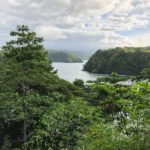
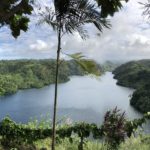

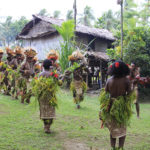
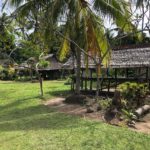
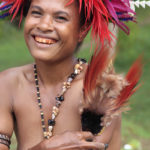
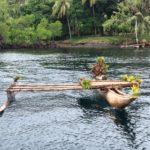
The following is our dry day, so we take further advantage of the terrestrial offerings at Tufi and tour two local villages. We arrive via boat and a village elder paddles out to ferry us to shore on a dugout canoe, made from a sago palm. Villagers in tribal dress lead us up the hill to the middle of the small settlement. There’s a traditional song-and dance-performance and demonstrations of local culture, such as fire-making, face-tattooing and traditional food preparation. Although we don’t on this trip, Tufi can arrange an overnight stay in a village guesthouse, as well as an early-morning trek to see the iconic bird of paradise after an overnight stay in Orotoaba village, about 45 minutes away. Next time, I think to myself as the boat delivers us back to the resort in the fading afternoon light.
The details
Getting there
Tufi’s remoteness is part of its charm, but it does necessitate forward planning in terms of arrival and departure. There are three flights per week, on Monday, Wednesday and Friday between Port Moresby and Tufi on PNG Air. Once you land on Tufi’s small airstrip you’re just around the corner from the hotel. Resort managers will meet you upon deplaning. From there, you can either walk the few minutes to the resort or catch a lift with your bags. PNG Air has a small office at Tufi, so after you check in for your departing flight, you’ll wait at the resort until you hear the plane approaching and repeat the process in reverse.
When to go
There are distinct dive seasons in PNG depending on where you go, as we found out during our stay at Tufi. Therefore, to make the most of your trip, time your visit properly with wherever you’re going. The best time to dive at Tufi is from November through March.
What to bring
Tufi — and all of PNG — is very remote. Bring your save-a-dive kit (extra mask straps, fin straps, etc.) and make sure your gear is in good working order before you arrive. Bring any medicine you think you might need as well, from Band-Aids to antibiotics. Better to have it and not need it than the other way around.
The post Scuba Diving in Papua New Guinea: Tufi Dive Resort appeared first on Scuba Diver Life.
from Scuba Diver Life https://ift.tt/2P94R4q
No comments:
Post a Comment